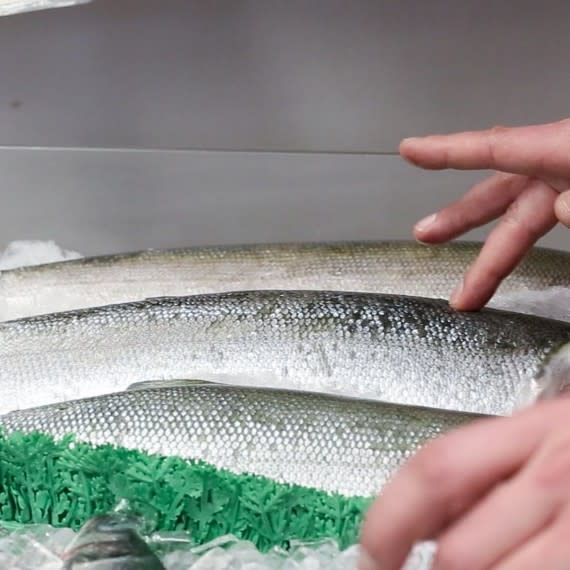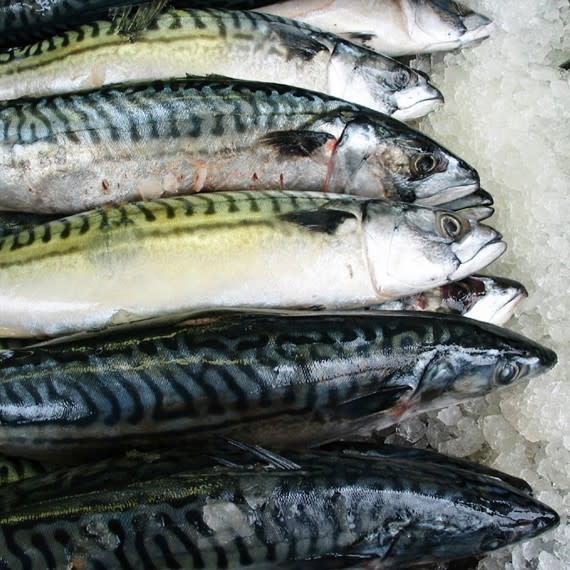How to Buy the Best Fish (Whether Fresh, Frozen, or Filleted)

(Via ChefSteps Team of ChefSteps)
A quick visual inspection will tell you whether it’s fresh or was prefrozen; handled properly or improperly; healthy or unhealthy. At ChefSteps, we buy properly treated animals, or we don’t buy them at all. Here’s what you need to know for your next seafood shopping trip.
Once the fish begins to deteriorate, the eyes dry out, become cloudy, and sink in or shrivel away. This indicates an unhealthy or improperly handled fish.
…
How to Select Whole Fish
CHECK THE EYES FOR CLARITY
They should be crystal-clear, plump, wet, and shiny, with no sunken features. If the eyes look good, you can bet with reasonable confidence that the fish is fresh and healthy.
CHECK THE FINS
The tail and dorsal fins should be healthy-looking, wet, and intact. A fish that’s been mishandled (penned too long or living in nets) will have torn or ragged fins, while an older fish’s fins will be dry and brittle.
POKE THE FLESH
If the monger allows it, try touching the fish for further signs of health and freshness. It should feel cold, wet, and slippery, but not sticky. When pressed, it should spring back to its natural shape, just like if you were to press on your own flesh. If it doesn’t spring back, it is a sure sign that the meat has softened and is no longer fresh.
CHECK THE GILLS
Check the gills for vitality and color. When first caught, a fish’s gills appear bright red and slowly darken over time. The gills should also feel clean and cold, not slimy.
TOUCH THE SCALES
Scales are designed to protect the animal from a harsh watery environment. When a fish is fresh, the scales will be shiny and firm, a veritable armor against the elements. Less fresh fish will often shed scales as you run your hand over them, and they may appear dry and flaky.
…
How To Select Filleted Or Butchered Fish
LOOK FOR CRACKS, BREAKS, AND POOLING WATER
Look for cracks in the fillet that run between the muscles and collagen sheaths (the white lines running through the fish). Breaks in the muscle itself tend to indicate mishandling. Pooling water inside the container usually indicates that the fish is aging and losing its ability to hold moisture.
INSPECT THE COLOR AND CONSISTENCY OF THE FLESH
For white fish, such as cod or halibut, the meat should look fairly translucent. If it is very opaque and extremely white, it’s a sign that the flesh is not fresh.
For darker meat, like tuna or salmon, the flesh should be bright and very saturated in color. Look for a clear color contrast between the fat and the muscle.
For all fish, make sure the flesh is wet and glossy. Flesh that is sticky, dry, or chalky has likely been handled improperly (held at warm temperatures), frozen and thawed several times, or is just plain old.
SELECTING THE CORRECT PARTS FOR YOUR DISH
In terms of edible parts, the body of a fish is quite simple compared to a mammal. The most important thing to consider is what you’ll be doing with the meat. Here are some tips for choosing wisely:
Tail: Tail meat is generally tougher, but cheaper, than fillets. That’s because muscles in this region do the most work in life. This cut is great for tartare, because the meat is tenderized by chopping, and then often further tenderized with salt, vinegar, and oil when it’s dressed. Try Martha’s simple recipe for Spicy Tuna Tartare.
Belly: The belly is the most expensive part, and also the fattiest. For an oily-tender fish like tuna, belly is delicious served raw or braised. Try fresh tuna belly sliced over Vinegared Sushi Rice.
Fillet: The fillet is lean, beautiful, tasty, and extremely versatile. Fillets will dry out quickly if overcooked, however, so treat them with care. We love a nice, fresh whitefish fillet with a simple breading, a little seasoning, and some fresh rosemary.
Collar: We like to compare the collar of the fish to a pork shoulder – they’re great for braising and slow-roasting. Try them in a savory fish stew, like Cioppino.
…

How To Choose And Use Frozen Fish
IF POSSIBLE, FIND OUT HOW IT WAS FROZEN
Frozen fish often gets a bad name because companies and fishmongers wait until it has already aged to freeze it. However, if it’s frozen right after it’s caught, it will be delicious when thawed. It should be frozen very quickly, preferably as soon as it is killed, and to very cold temperatures, around -22 °F / -30 °C, to minimize ice-crystal damage to the tissue.
MAKE SURE THE PACKAGE IS WELL SEALED
If you see freezer-burn marks or ice crystals, skip it.
THAW SLOWLY
The safest way to thaw fish is slowly, in the refrigerator. Home cooks can simply place the frozen piece on a plate or a tray in the fridge, and allow it to thaw for about 24 hours. Yes, thawing on the countertop will be faster, but thawing in the fridge will better protect your product.
More from Martha Stewart:
20 Classic Comfort Food Recipes from Martha Stewart
36 Dinners You Can Make in Just 15 Minutes!
42 Slow-Cooker Recipes Worth the Wait
DIY Dried Fruit Granola Bites
Very Green Cucumber and Pear Juice
